Comparing Fabric Pens and Pencils
Testing results for multiple quilt-marking implements across 10 brands.
WHAT FOLLOWS
Overview of fabric marking implements
Overview of testing
Pearls, aka a few things I learned along the way
Fabric pencils/pens/markers: results and comments
Overview of fabric marking implements
Vocabulary
“Marking implement” – generic term for a marker, pen, or pencil
“Marker” – a marking implement with a felt tip
“Pen” – a marker with a roller ball tip and liquid ink
“Pencil” – a marker where the marks are made by a substance that can be sharpened or is pre-sharpened like a mechanical pencil
Criteria for determining which brands/markers to include
I used the marking implements I had on hand along with more that fellow quilter and friend, Anniessa, gave me to test (thanks!), and the three that were the most requested by readers of this substack. I ended up with 32 marking implements across 8 brands (not including the permanent markers I tested).
Example of how I identify each implement in this newsletter:
“Water Soluble Pencil Clover Japan” with Japanese writing | pencil, (blue), rub to erase
This implement is a pencil with “Water Soluble Pencil Clover Japan” and Japanese writing printed on the shaft which produces a blue pencil mark that is removed by rubbing.
Some brands, inexplicably, do not have brand names and/or other descriptive words on the implement shafts (Dritz and to some extent Sewline, I am talking about you). For these, I use the name on the package, but put it in square brackets like this:
[Dritz Quilting Heat Erase Marking Pen] | pen, (red), heat-erase
To summarize, quotes indicate writing on the pen, square brackets indicate writing on the package.
I also decided to test the permanent black markers I had lying around, because, well, why not?
Overview of testing
Marking implements that made dark marks were tested on white fabric. Marking implements that made light marks were tested on dark blue fabric. Marking implements that made medium-colored marks, such as pink or yellow, were tested on both white and dark blue fabric.
For each test I made a little “W” shape. I made six panels with white fabric and six panels with dark blue fabric that each had a full set of Ws. The six panels were then handled as follows:
Do nothing, STOP
Iron, STOP
Wash, no iron, STOP
Wash, iron, STOP
Wash, iron, leave in Wisconsin garage overwinter to check reappearance, STOP. This freeze test did not result in any changes in either direction; no marks that had been removed reappeared and no marks that were visible disappeared (more on this at the very end when I discuss the Pilot Frixion Clicker 07 Erasable pens).
Wash, iron, leave in south-facing Arizona garage windows, and wait four months to check for fading. STOP. This fade test did not result in any changes in either direction; no marks that had been removed reappeared and no marks that were visible disappeared.
Pearls, aka a few things I learned along the way
Pearl #1: ALWAYS test marking implements with a scrap piece of your fabric, especially if you need to iron before fully removing the marks.
Pearl #2: Unless it is a heat-erase implement, be careful not to iron over marks before the marks are erased per directions for that implement, be it rubbing off, sitting in the air, or spritzing/washing with water).
Marking implements designed to be erased by heat are not set by heat (let’s hope not!), but ironing over marks made by implements not designed to be erased by heat would often permanently “set” the marks.
Pearl #3: For marking light fabrics, the air- and water-erase pens by Sewline were superior to the other items tested.
Pearl #4: UPDATED
I originally wrote, “For marking dark fabrics, the Dritz Quilting Heat Erase Marking Pen (white) worked best.” Now I have a new favorite, the Water Soluble pencil by Clover.
OK, so here’s what happened and why I changed my recommendation. After posting this newsletter I was cleaning up and I found an unopened package of water soluble pencils by Clover and noticed a secondary instruction sheet I didn’t have when I did the original testing.
I read the instructions and realized I followed a different procedure in my initial testing. At the same time, I was preparing to begin quilting a quilt with some dark fabrics, and was feeling hesitant to use the white Dritz heat-erase pen (my previous pick) even though I could not get the marks to reappear after a long time in the cold.
So I did a new test. I marked on some dark fabric with each of the three clover colors, waited a bit, wet a cloth, and rubbed them off. It worked great! As in really, really, great. Note, DO NOT iron these (or any) pencil marks. After ironing and rubbing with a damp cloth I could still see faint lines.
From the original post, “The Dritz Quilting Heat Erase Marking Pen didn’t go on super smooth, but it made an easy-to-see mark that was completely removed after ironing. Note, this pen is only available as part of a set.”
Pearl #5: Of the permanent markers - that is marks made to last, as in for writing a label - the two made for fabric, “Fabrico Dual marker, #182” and “Kid Made Modern Textile Marker”, were far superior to the other pens.
The marks they made were crisp and clean. They were thicker than the Sharpie fine point or Micron pens, but the marker tip glided over the fabric much more smoothly than the other pens. Note, the Kid Made pen resulted in lines were slightly greyer than the more black lines by the Fabrico pen.
Permanent markers tested (all were black):
“Fabrico Dual marker, #182”
“GXIN G-107A Double Head CD/DVD Color Ink Pen Marker”
“Herlitz Permanent Colli Marker”, 1-4mm
“Kid Made Modern Textile Marker”
“Pigma Micron Archival Ink, 08”
“Prismacolor Premier Fine Line Marker, 08”
“Sharpie Permanent Marker, ultrafine point”
Pearl #5: Regular, not-made-for-use-on-fabric, mechanical pencils are terrible. The lead does not fully erase with rubbing or water.
Pearl #6: Chalk is hard to use.
The lines are fat, the chalk is either too loose and is gone before I am ready to cut/sew or it is too tenacious, and I could not get rid of it. In addition, lots of times when I would sharpen a chalk pencil big chunks would fall out. Making things worse, a freshly sharpened pencil has a fine line that gets fatter and fatter as the nub gets worn down.
Fabric pencils/pens/markers: results and comments
Summary of implements that are erased by rubbing
“Bohin France” | mechanical chalk pencil, (white and gray), rub to erase
VERDICT: Unacceptable
Marking: The chalk/lead used in these pencils is very hard. It was difficult to get them to make a mark.
Erasing: It was also difficult to remove the mark. With really good lighting the white was ever so slightly visible. The gray showed up regardless of what I did to remove it.
“Clover” [White Chaco Liner Pen] | powder, (white), rub/brush off
VERDICT: Unacceptable
Marking: The chalk made a mess and often rubbed off before I was able to cut/quilt.
Erasing: The mark was completely gone after washing.
[Dritz Soapstone Marking Pencil] | pencil, (white), rub to erase
VERDICT: Unacceptable
Marking: The soapstone made an irregular thick > thin > thick line.
Erasing: The mark was barely visible, even after washing.
“Fons & Porter Chalk Pencil Yellow” | pencil, (yellow), rub to erase
“Fons & Porter Chalk Pencil Blue” | pencil, (blue), rub to erase
“Fons & Porter Chalk Pencil Gray” | pencil, (gray), rub to erase
VERDICT: Unacceptable
Marking: Lead “gripped” the fabric. The marks did show up very well.
Erasing: White and yellow remained visible. Blue and grey were removed, with effort, but only when the fabric was washed before it was ironed. Ironing “set” the marks.
“Quilting Clean Erase EZ International” | pencil, (gray), rub to erase
“Quilting Clean Erase EZ International” | pencil, (white), rub to erase
VERDICT: Unacceptable
Marking: Very, very, difficult to get any marks.
Erasing: Not relevant, there was hardly any mark to remove.
Everyday mechanical pencil with B lead (gray)
VERDICT: Unacceptable
Marking: Difficult to get any marks.
Erasing: Nearly impossible to remove the marks.
Summary of implements erased by sitting a while, aka, “air-erase”
“Air Erasable Marker Clover” | 2-sided marker with an eraser on end, (purple), air/time to erase
VERDICT: Acceptable
Marking: Very, very thin marks, the pen dragged on the fabric a bit
Erasing: Marks were gone after 24 hours.
“Air Erasable Marker Thick Clover” | marker, (purple), air/time to erase
VERDICT: Acceptable
Marking: Thick marks
Erasing: Most samples had no trace of marking, but the sample left without water (only air/time) is still slightly visible.
[Dritz] “Disappearing Ink Mark-B-Gone” | 2-sided marker, (purple), purple cap air/time/water erase
VERDICT: Acceptable
Marking: Thick marks
Erasing: Marks were gone after 24 hours.
“AIRerasing Sewline” | pen, (purple), air/time/water to erase
VERDICT: Best
Marking: Easiest marking of the thin pens.
Erasing: Marks were gone after 24 hours.
Summary of implements that are erased by spritzing or washing with water, aka, “water-erase”
“Water Soluble Pencil Clover Japan” with Japanese writing | pencil, (pink), water to erase
“Water Soluble Pencil Clover Japan” with Japanese writing | pencil, (blue), water to erase
VERDICT: Great! It’s the best option for dark fabrics
Marking: Goes on smoothly, but line thickness depends on how sharp the pencil tip is. Also, it does rub off a bit even without water if the fabric is handled a lot.
Erasing: When used and removed as instructed (mark lightly and rub with a damp cloth) the lines disappeared.
*Always wash before ironing or the marks get “set”.
“Crayola Ultra-Clean Washable” | marker, (gray), water to erase
“Crayola Ultra-Clean Washable” | marker, (yellow), water to erase
“Crayola Ultra-Clean Washable” | marker, (blue), water to erase
“Crayola Ultra-Clean Washable” | marker, (pink), water to erase
VERDICT: Acceptable
Marking: Thick marks
Erasing: Washing removed the marks completely.
[Dritz] “Fine Line Disappearing Ink” | marker, (purple), air/time/water erase
VERDICT: Acceptable
Marking: Very, very thin marks
Erasing: Marks were gone after spritzing with water.
[Dritz] “Disappearing Ink Mark-B-Gone” | 2-sided marker, (blue), blue cap water erase
VERDICT: Acceptable
Marking: Thick marks
Erasing: Marks were gone after spritzing with water.
“EZ International China” | marker, (blue), water to erase
VERDICT: Acceptable
Marking: Medium marks
Erasing: Marks were gone after spritzing with water.
“Water erasing Styla” [Sewline] | pen, (purple), water to erase
VERDICT: Best
Marking: Easiest marking of the thin pens.
Erasing: Marks were gone after spritzing with water.
Summary of implements that are erased by ironing, aka, “heat-erase” or “iron erase”
[Dritz Quilting Heat Erase Marking Pen] | pen, (red), heat-erase
[Dritz Quilting Heat Erase Marking Pen] | pen, (green), heat-erase
[Dritz Quilting Heat Erase Marking Pen] | pen, (blue), heat-erase
[Dritz Quilting Heat Erase Marking Pen] | pen, (black), heat-erase
VERDICT: Acceptable
Marking: Did not go on completely smoothly.
Erasing: Marks were gone after ironing. Marks did not fade unless they were ironed.
[Dritz Quilting Heat Erase Marking Pen] | pen, (white), heat-erase
VERDICT: Best for dark fabrics
Marking: Did not go on completely smoothly.
Erasing: Marks were gone after ironing. Marks did not fade unless they were ironed.
“Pilot Frixion Clicker 07 Erasable” | pen, (red), heat erase
“Pilot Frixion Clicker 07 Erasable” | pen, (blue), heat erase
“Pilot Frixion Clicker 07 Erasable” | pen, (black), heat erase
VERDICT: Acceptable-sorta*
Marking: Feels like writing with a ball point pen. Note, the mechanism to expose the roller ball is not intuitive. To get it to come out, the clear-colored little clip part needs to be slid along the shaft.
Erasing: Marks were gone after ironing. Marks did not fade unless they were ironed.
*The “Pilot Frixion Clicker 07 Erasable” pens are advertised to be “erasable” with rubbing, but that is only true when they are used on paper. On fabric the ink needed heat to disappear. In addition, the ink has the characteristic that, according to the package, it disappears when exposed to temperatures over 140 degrees F (heat) then reappears when exposed to temperatures below 14 degrees F. If you believe everything you read online, some quilters have used these pens to mark a quilt, then watched in amazement when the marks disappeared with ironing, only to then be horrified to see the marks reappear when the quilt was stored in a cold attic or trunk of a car. Two things, (1) I froze some samples in a deep freeze for two months and could not get the marks to reappear and (2) some of the people who have reported that the marks reappeared further reported they could get the marks to re-disappear when they re-ironed the quilt. I couldn’t test this because I couldn’t get the marks to reappear.




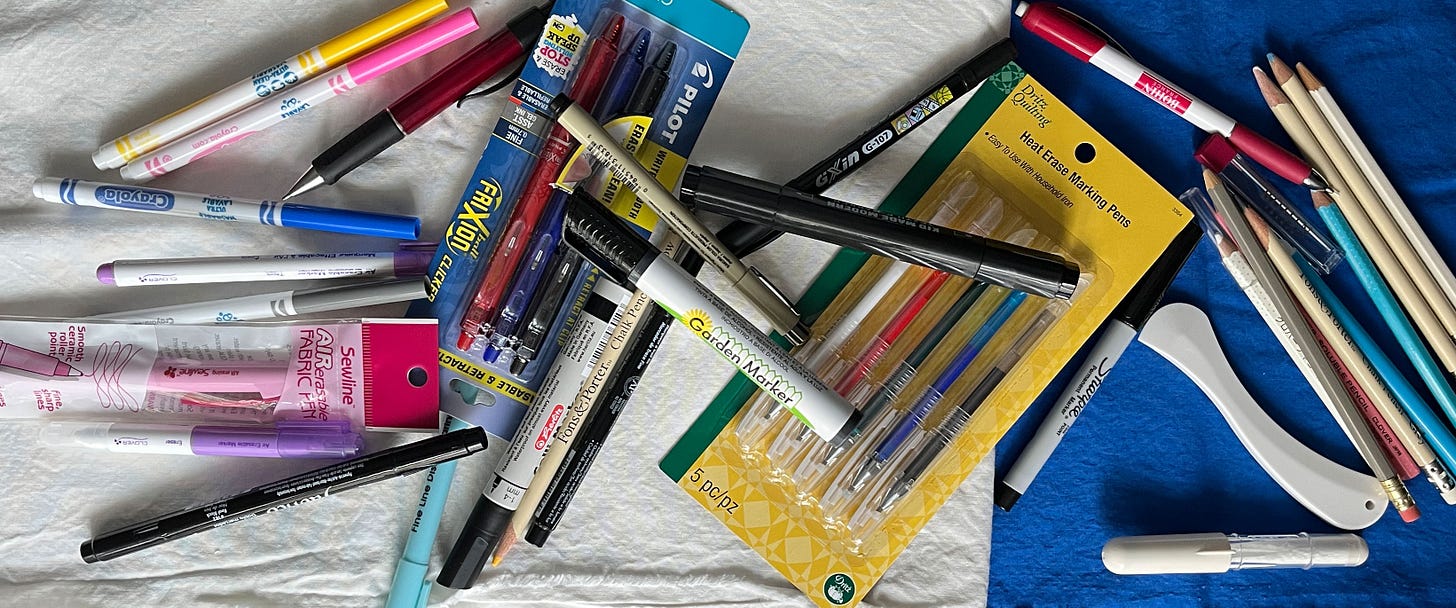
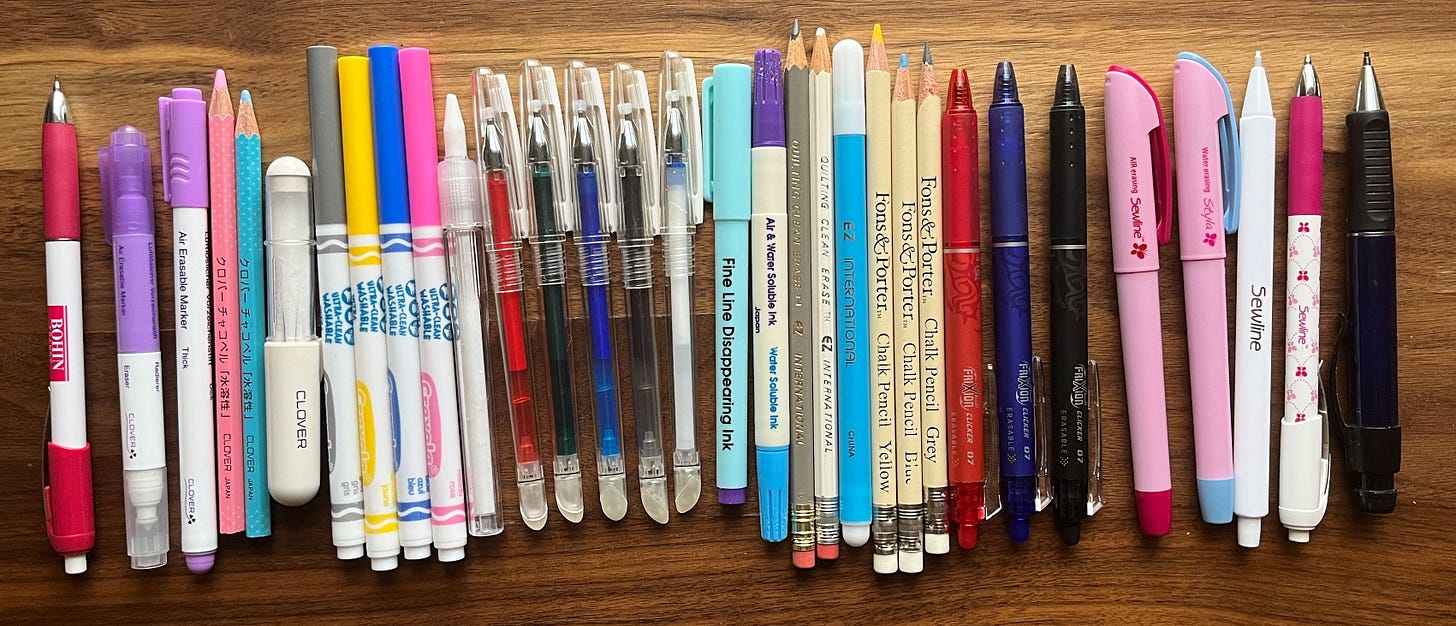
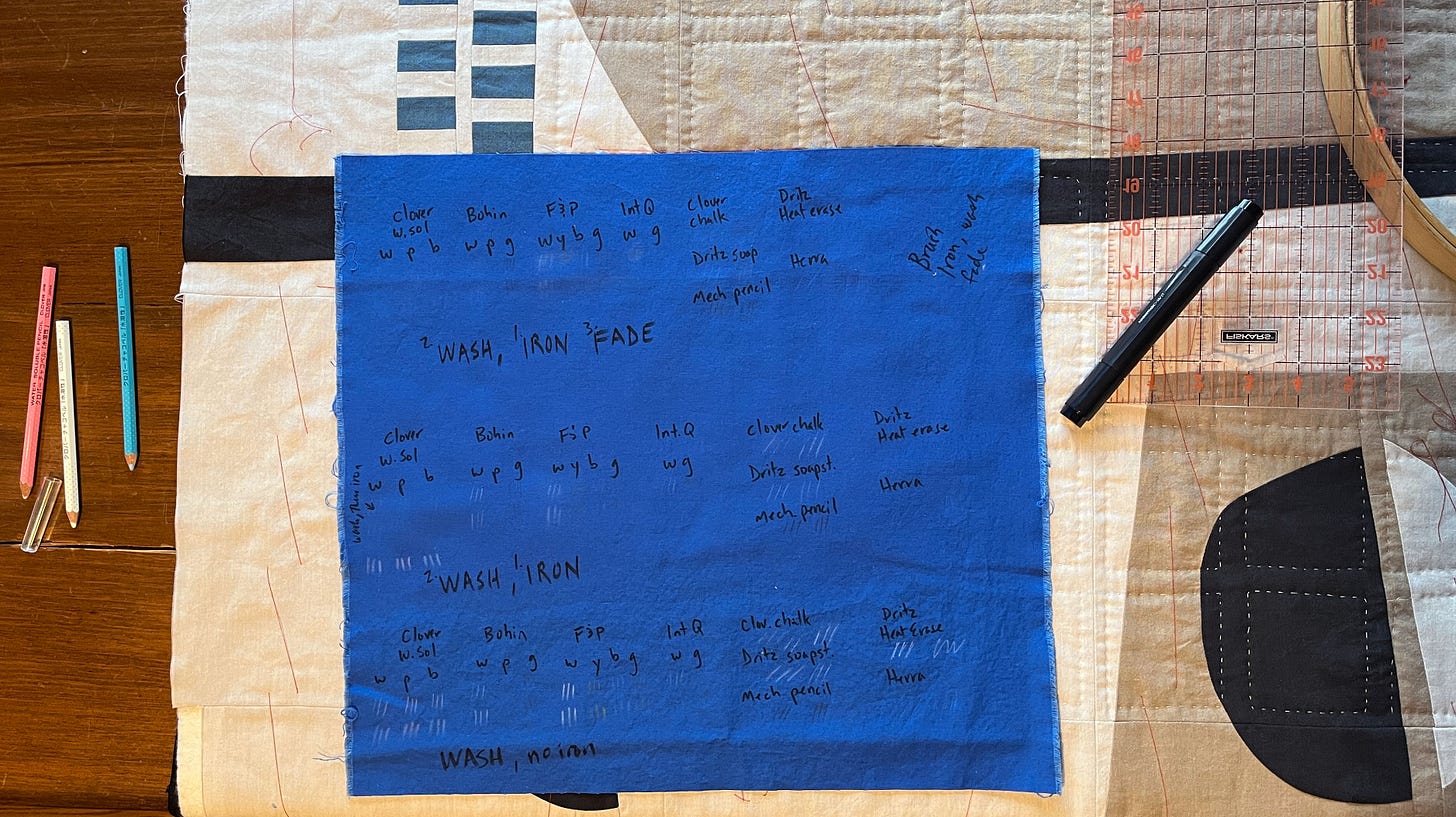
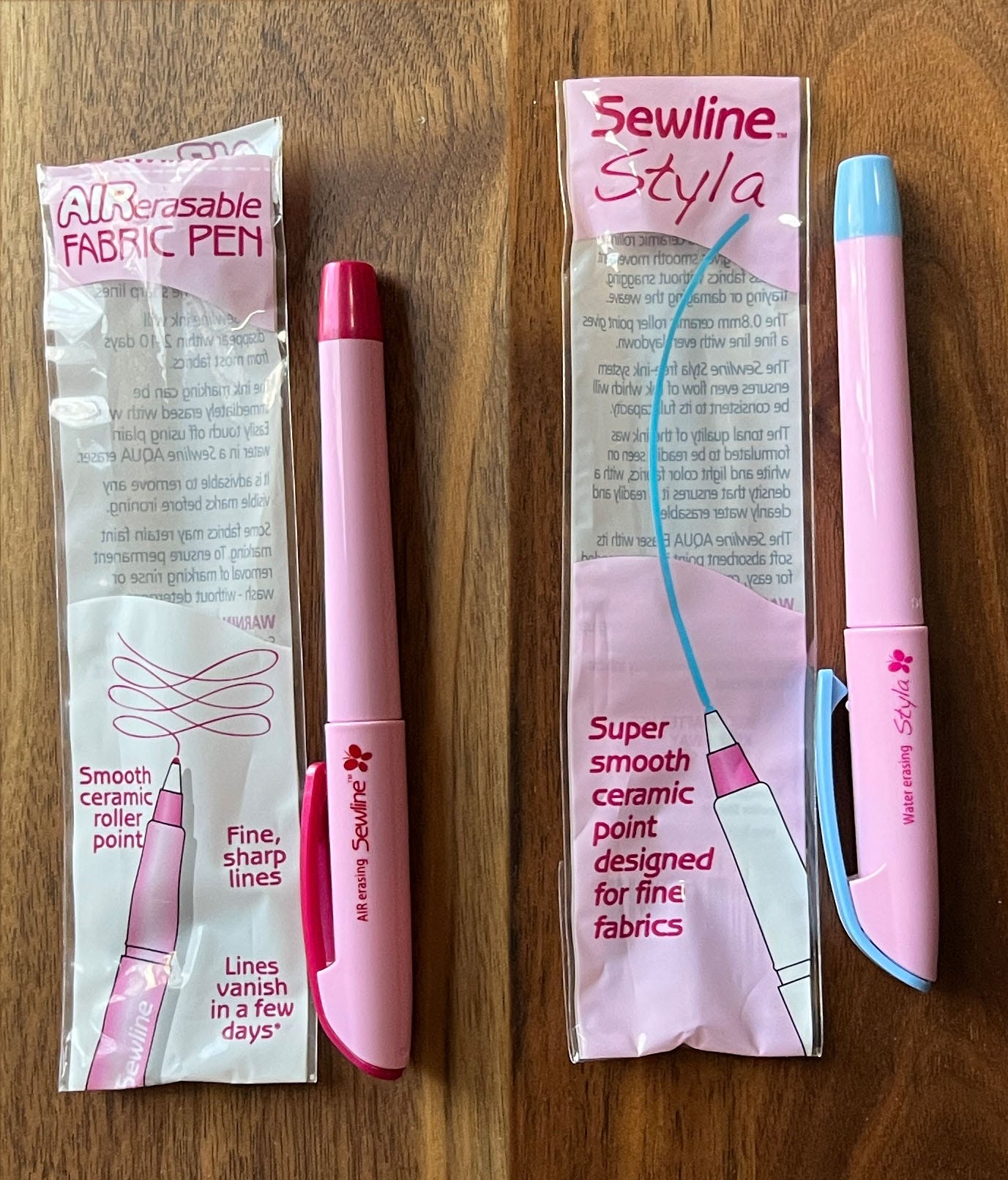
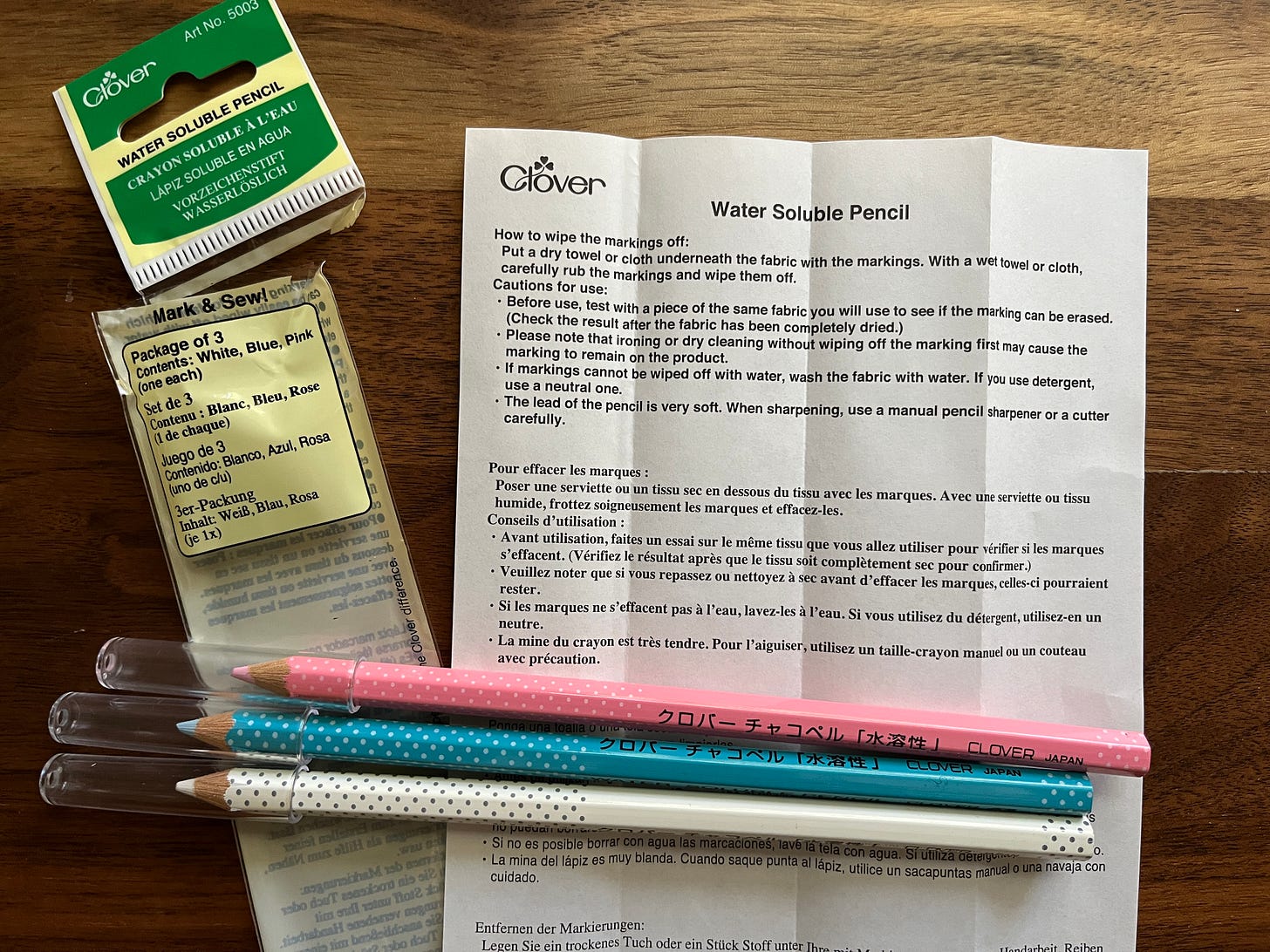

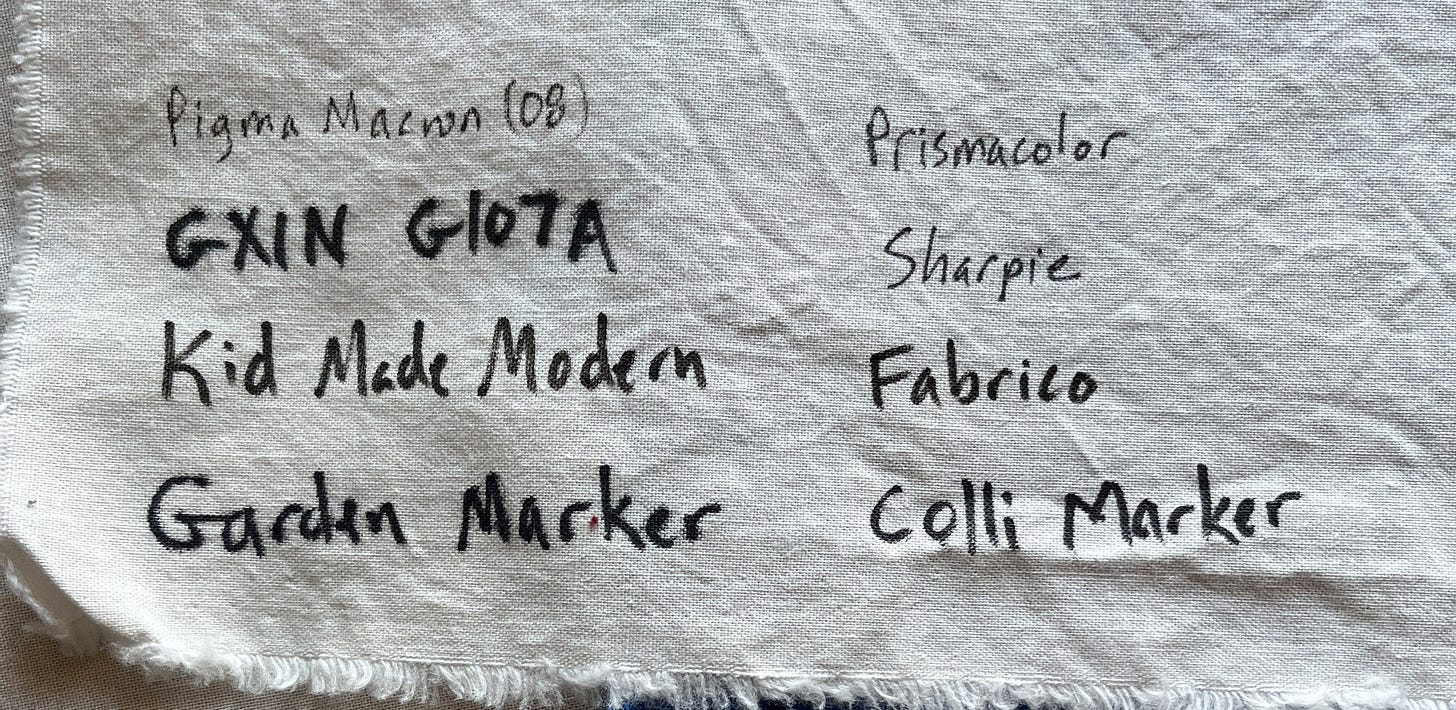
Thank you for this informative post! I’m looking for a pen for my niece’s signature quilt for her wedding, and your advice will steer me in the right direction.
I've been tearing my hair out trying to find something to mark quilting lines that isn't incredibly frustrating to use. This is exactly what I needed. Thank you so much for your work.